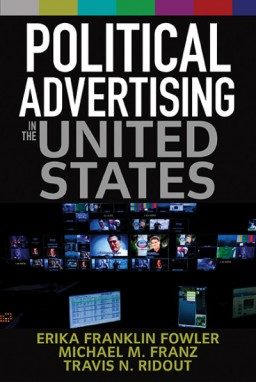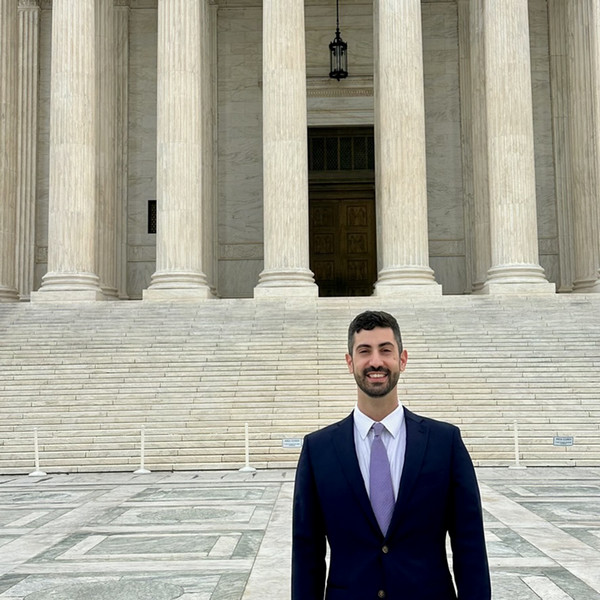Michael Franz Discusses Political Advertising on Television
By Tom Porter
This is certainly true in the field of advertising, said Associate Professor of Government Michael Franz. Speaking in a community lecture on campus October 6, 2016, Franz said television ad spending in the current presidential cycle shows some unusual trends.
He also spoke of the types of ads that are most effective, and the influence of outside groups on ad spending. Franz has authored five books, including The Persuasive Power of Campaign Advertising and Choices and Changes: Interest Groups in the Electoral Process.
He also serves as co-director of the Wesleyan Media Project, which tracks and codes political ads in federal elections.
His lecture was titled Ad Nauseam: Political Advertising in the 2016 Presidential Election.
Listen to an interview with Michael Franz (audio may take a few seconds to load)
Edited interview transcript
Why did you title your lecture “Ad Nauseam”?
Oftentimes people express dissatisfaction with the amount of campaign ads we’re seeing, and we see tens and tens of thousands of campaign ads in the most competitive states across the country. So in some sense people feel that this is “ad nauseam.”
Give us a sense of how much these television ads have increased in the last few years, particularly since the Citizens United Supreme Court decision in 2010?
We have seen in the presidential race two or three times as many ads airing on TV as there were fifteen or sixteen years ago. But of more importance to me is that the amount of money and ads from outside organizations—the non-candidates, the non-party committees—has increased leaps and bounds in the last ten or twenty years, and that’s because of the Citizens United case which essentially stripped away all the rules.

What about the effectiveness of the ads? How do you measure that and how effective are they?
Ads are effective. They can bring about some change in the vote but the effect sizes are not very large and they don’t last very long. If you stop advertising two or three weeks before the election, there would be no effect on election day, because people forget these ads. So you need to out-advertise your opponent, but even if you do, you might only get one or two percentage points more than if you didn’t.
It seems like a zero-sum game, where you have to advertise just to stay level.
Absolutely, it’s really about neutralizing the effect from the other side, and so it’s an arms race of advertising, and so you do spend all that money just to make sure the other side doesn’t get those one or two percentage points, which matters a lot in a close race.
Are there any data about which types of adverts are more effective?
This is something we keep struggling with. One way to think of it is “let’s just look at who airs more ads, they should do better than those who don’t.” That tends to be true, but then different ads can be more or less effective. You can get more bang for your buck with a really good ad compared to a bad one, and that we know less about. We know for example that negative ads are modestly maybe more effective than positive ads, and we know that ads based on policy issues are probably a little more effective than ads about the characteristics of a candidate, but it’s tough to know.
Do you correlate this by comparing polling results with increases in ad spending?
Right, so we compare in two ways: one, we look at ad buys versus election results after the election; another way would be to compare polling changes with ad trends, so you could look within an election to see if changes in ad buys correlate with changes in polls. We do all of those things.
It was interesting that you mentioned how people tend to be more influenced by ads from outside groups than ads from the candidates themselves.
Yes that’s what the research is showing. One reason is that it seems as if people want to punish candidates for when they go on the attack. If they attack an opponent, voters say they don’t like negative ads, so what they might do is like the opponent less, but they also like you less for going negative. But an outside group, if they run a negative ad, will induce voters to like the attacked candidate less, but they don’t know how to like the sponsor less, because the sponsor’s not a candidate, and so their anger at the attack dissipates and what’s left is just the effect on the opponent. So on balance you might get stronger effects from groups than from candidates.
Looking at the current presidential election cycle, the way that the Donald Trump campaign has produced very little in the way of direct TV ads has kind of ripped up the rule book hasn’t it?
That’s right, there have been few ads from the Trump campaign at the top of the ticket, and there have been few superPAC or supportive group ads in support of Trump. But there’s plenty of money, and so that money is pushed down-ballot, to Senate races and House races, particularly to Senate races. The Senate is the key prize if you think about the Supreme Court vacancy, and so a lot of money—more than we’ve ever seen—is going into those competitive Senate races, because they will determine the balance of power.
So the GOP is distancing itself from Trump because of some of the negative comments he’s made, which means more money available for other races right?
Yes. If you look at the Republican Party itself, the RNC, the traditional party organization, has spent no money on behalf of Trump, zero dollars, whereas what they did for Mitt Romney and John McCain in the last two cycles was huge. They were very supportive of those candidates and that meant less money for congressional races. Now, all the Republican money can go to congressional races, which is exactly what’s happening.
You’re just focusing on TV ads, and many young people don’t watch TV any more, they prefer streaming content. How are you going to factor that in?
We don’t have the data on that, and it will change over time. But it turns out that younger people vote at lower rates than older people and older people watch more television, so traditional TV still matters in that way. But, as the electorate gets older, and as millennials move into middle age in the next fifteen or twenty years, they’re going to be consuming media like they always have, online and streaming, and all the ads are going to go there. And so you will see a tipping point in some future election cycle, where TV ads, as we’ve often seen them, will start to look very different.



